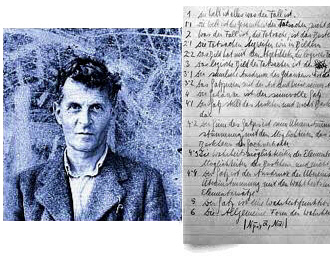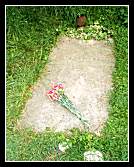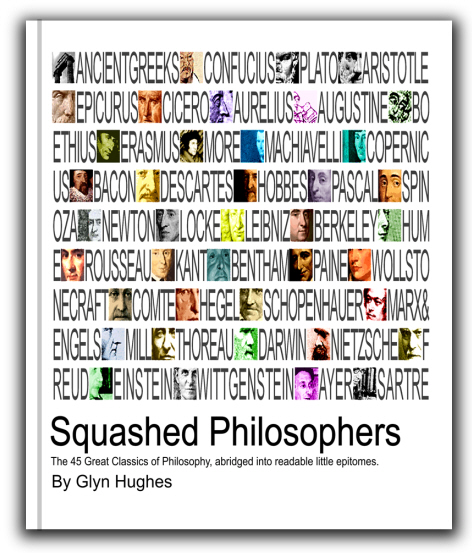

|
|
|
|
Tractatus Logico-Philosophicus ... Squashed down to read in about 25 minutes "The world is the totality of facts, not of things"   Wikipedia - Wikipedia -  Full Text - Full Text -  Print Edition: ISBN 0415254086 Print Edition: ISBN 0415254086© This page does not contain Tractatus Logico-Philosophicus, but a short abridgement for private study and research only. Copyright may exist on the original work.
Ludwig Wittgenstein was born in Vienna on 1889 of a family of immensely wealthy Austrian steelmakers and musicians, with an unfortunate family trait of depression - three of his four brothers committed suicide. He was educated at home until the age of 14, then at the Realschule in Linz, where Adolf Hitler was a fellow-pupil. Wittgenstein went on to study aeronautical engineering at Manchester, the complexities of which led him to question the basis of mathematics and seek an explanation from one of its wise men - Bertrand Russell of Cambridge. Wittgenstein believed that the Tractatus, with its strange combination of logic and mysticism, had solved all the problems of philosophy by realising that they were just problems of language. He therefore gave up academe to work as a schoolteacher and a monastery gardener. Only some years later did he realise that things weren't that simple, and found a new philosophical method and a new understanding of language, to eventually be expressed in the posthumously-published Philosophical Investigations.
This version is based on the translation from the German by C.K. Ogden, the man who developed the 'Basic English' system of language learning. It reduces the original 27,000 words to about 3,500.
Have a look at a Squashed Version of someone who didn't approve of Wittgenstein's linguistic 'philosophy' at all: Karl Popper. Or read the old classic which more-or-less founded this style of presenting ideas: Spinoza's 'Ethics'
Ludwig Wittgenstein 1921 Squashed version edited by Glyn Hughes © 2011 INTRODUCTION By Bertrand Russell FRS Mr Wittgenstein's Tractatus Logico-Philosophicus, whether or not it prove to give the ultimate truth on the matters with which it deals, certainly deserves, by its breadth and scope and profundity, to be considered an important event in the philosophical world. In order to understand Mr Wittgenstein's book, it is necessary to realize what is the problem with which he is concerned. In the part of his theory which deals with Symbolism he is concerned with the conditions which would have to be fulfilled by a logically perfect language. The first requisite of an ideal language would be that there should be one name for every simple, and never the same name for two different simples. A name is a simple symbol in the sense that it has no parts which are themselves symbols. A fact which has no parts that are facts is called by Mr Wittgenstein a Sachverhalt, or an atomic fact. The world is fully described if all atomic facts are known, together with the fact that these are all of them. The world is not described by merely naming all the objects in it; it is necessary also to know the atomic facts of which these objects are constituents. Given this total of atomic facts, every true proposition, however complex, can theoretically be inferred. A proposition (true or false) asserting an atomic fact is called an atomic proposition. All atomic propositions are logically independent of each other. No atomic proposition implies any other or is inconsistent with any other. Mr Wittgenstein's explanation of his symbolism is not quite fully given in the text. The symbol he uses is  where: p stands for all atomic propositions. ξ stands for any set of propositions. N(ξ) stands for the negation of all the propositions making up ξ The whole symbol means whatever can be obtained by taking any selection of atomic propositions, negating them all, then taking any selection of the set of propositions now obtained, together with any of the originals - and so on indefinitely. This is, he says, the general truth-function and also the general form of proposition. What is meant is somewhat less complicated than it sounds. The symbol is intended to describe a process by the help of which, given the atomic propositions, all others can be manufactured. From this uniform method of construction we arrive at an amazing simplification of the theory of inference, as well as a definition of the sort of propositions that belong to logic. To have constructed a theory of logic which is not at any point obviously wrong is to have achieved a work of extraordinary difficulty and importance. This merit, in my opinion, belongs to Mr Wittgenstein's book, and makes it one which no serious philosopher can afford to neglect. Bertrand Russell May 1922 DAVID H. PINSENT Motto: . . . und alles, was man weiss, nich bloss rauschen und brausen gehört hat, lässt sich in drei Worten sagen. (and whatever a man knows, whatever is not mere overheard rumbling and roaring, can be said in three words) - Kürnburger PREFACE PROPOSITIONS UNDER 1 1 The world is all that is the case. 1.1 The world is the totality of facts, not of things. 1.11 The world is determined by the facts, and by their being all the facts. 1.12 For the totality of facts determines what is the case, and also whatever is not the case. 1.13 The facts in logical space are the world. 1.2 The world divides into facts. 1.21 Each item can be the case or not the case while everything else remains the same. PROPOSITIONS UNDER 2 2 What is the case - a fact - is the existence of states of affairs. 2.01 A state of affairs (a state of things) is a combination of objects (things). 2.02 Objects are simple. 2.03 In a state of affairs objects fit into one another like the links of a chain. 2.033 Form is the possibility of structure. 2.04 The totality of existing states of affairs is the world. 2.05 The totality of existing states of affairs also determines which states of affairs do not exist. 2.063 The sum-total of reality is the world. 2.1 We picture facts to ourselves. 2.11 A picture presents a situation in logical space, the existence and non-existence of states of affairs. 2.12 A picture is a model of reality. 2.14 What constitutes a picture is that its elements are related to one another in a determinate way. 2.141 A picture is a fact. 2.15 The fact that the elements of a picture are related to one another in a determinate way represents that things are related to one another in the same way. 2.172 A picture cannot, however, depict its pictorial form: it displays it. 2.181 A picture whose pictorial form is logical form is called a logical picture. 2.19 Logical pictures can depict the world. 2.2 A picture has logico-pictorial form in common with what it depicts. 2.221 What a picture represents is its sense. 2.223 In order to tell whether a picture is true or false we must compare it with reality. 2.224 It is impossible to tell from the picture alone whether it is true or false. 2.225 There are no pictures that are true a priori. PROPOSITIONS UNDER 3 3 A logical picture of facts is a thought. 3.01 The totality of true thoughts is a picture of the world. 3.03 Thought can never be of anything illogical, since, if it were, we should have to think illogically. 3.0321 Though a state of affairs that would contravene the laws of physics can be represented by us spatially, one that would contravene the laws of geometry cannot. 3.1 In a proposition a thought finds an expression that can be perceived by the senses. 3.2 In a proposition a thought can be expressed in such a way that elements of the propositional sign correspond to the objects of the thought. 3.203 A name means an object. The object is its meaning. ('A' is the same sign as 'A'.) 3.221 Objects can only be named. Signs are their representatives. I can only speak about them: I cannot put them into words. Propositions can only say how things are, not what they are. 3.3 Only propositions have sense; only in the nexus of a proposition does a name have meaning. 3.326 In order to recognize a symbol by its sign we must observe how it is used with a sense. 3.328 If a sign is useless, it is meaningless. That is the point of Occam's maxim. 3.332 No proposition can make a statement about itself, because a propositional sign cannot be contained in itself. 3.4 A proposition determines a place in logical space. The existence of this logical place is guaranteed by the mere existence of the constituents - by the existence of the proposition with a sense. 3.411 In geometry and logic alike a place is a possibility: something can exist in it. 3.42 A proposition can determine only one place in logical space 3.5 A propositional sign, applied and thought out, is a thought. PROPOSITIONS UNDER 4 4 A thought is a proposition with a sense. 4.001 The totality of propositions is language. 4.022 Man possesses the ability to construct languages capable of expressing every sense, without having any idea how each word has meaning or what its meaning is - just as people speak without knowing how the individual sounds are produced. It is not humanly possible to gather immediately from it what the logic of language is. Language disguises thought. 4.003 Most of the propositions and questions to be found in philosophical works are not false but nonsensical. Consequently we cannot give any answer to questions of this kind, but can only point out that they are nonsensical. Most of the propositions and questions of philosophers arise from our failure to understand the logic of our language. And it is not surprising that the deepest problems are in fact not problems at all. 4.0031 All philosophy is a 'critique of language'. The apparent logical form of a proposition need not be its real one. 4.01 A proposition is a picture of reality as we imagine it. 4.014 A gramophone record, the musical idea, the written notes, and the sound-waves, all stand to one another in the same internal relation of depicting that holds between language and the world. There is a general rule by means of which the musician can obtain the symphony from the score. That is what constitutes the inner similarity between these things. 4.022 A proposition shows its sense. A proposition shows how things stand if it is true. And it says that they do so stand. 4.024 To understand a proposition means to know what is the case if it is true. 4.05 Reality is compared with propositions. 4.06 A proposition can be true or false only in virtue of being a picture of reality. 4.063 An analogy to illustrate the concept of truth: imagine a black spot on white paper: you can describe the shape of the spot by saying, for each point on the sheet, whether it is black or white. To the fact that a point is black there corresponds a positive fact, and to the fact that a point is white (not black), a negative fact. 4.1 Propositions represent the existence and non-existence of states of affairs. 4.11 The totality of true propositions is the whole of natural science 4.111 Philosophy is not one of the natural sciences. 4.112 Philosophy aims at the logical clarification of thoughts. Philosophy is not a body of doctrine but an activity. A philosophical work consists essentially of elucidations. Without philosophy thoughts are, as it were, cloudy and indistinct: its task is to make them clear and to give them sharp boundaries. 4.1122 Darwin's theory has no more to do with philosophy than any other hypothesis in natural science. 4.113 Philosophy sets limits to the much disputed sphere of natural science. 4.121 Propositions cannot represent logical form: it is mirrored in them. 4.1212 What can be shown, cannot be said. 4.2 The sense of a proposition is its agreement and disagreement with possibilities of existence and non-existence of states of affairs. 4.21 The simplest kind of proposition, an elementary proposition, asserts the existence of a state of affairs. 4.211 It is a sign of a proposition's being elementary that there can be no elementary proposition contradicting it. 4.22 An elementary proposition consists of names. It is a nexus, a concatenation, of names. 4.242 Expressions of the form 'a = b' are, therefore, mere representational devices. They state nothing about the meaning of the signs 'a' and 'b'. 4.243 Can we understand two names without knowing whether they signify the same thing or two different things? - Can we understand a proposition in which two names occur without knowing whether their meaning is the same or different? Suppose I know the meaning of an English word and of a German word that means the same: then it is impossible for me to be unaware that they do mean the same; I must be capable of translating each into the other. Expressions like 'a = a', and those derived from them, are neither elementary propositions nor is there any other way in which they have sense. 4.25 If an elementary proposition is true, the state of affairs exists: if an elementary proposition is false, the state of affairs does not exist. 4.26 If all true elementary propositions are given, the result is a complete description of the world. 4.3 Truth-possibilities of elementary propositions mean Possibilities of existence and non-existence of states of affairs. 4.31 We can represent truth-possibilities by schemata of the following kind ('T' means 'true', 'F' means 'false'; the rows of 'T's' and 'F's' under the row of elementary propositions (pqr, pq, p) symbolize their truth-possibilities in a way that can easily be understood):
4.4 A proposition is an expression of agreement and disagreement with truth-possibilities of elementary propositions.
5.3 All propositions are results of truth-operations on elementary propositions.  Ludwig Wittgenstein 1889-1951 Wittgenstein's grave in the grounds of the Church of the Ascension, Cambridge, England  ISBN 9781326806781 |